Eurozone Bank Risks and the Carry Trade
VerifiedAdded on 2020/01/28
|11
|3067
|54
Report
AI Summary
This assignment delves into the complex issues surrounding eurozone bank risks and the phenomenon known as the 'carry trade'. It explores how external imbalances and self-fulfilling crises can threaten the stability of European banks. The analysis incorporates economic indicators such as inflation, bond yields, and cost of living across various Eurozone member states.
Contribute Materials
Your contribution can guide someone’s learning journey. Share your
documents today.
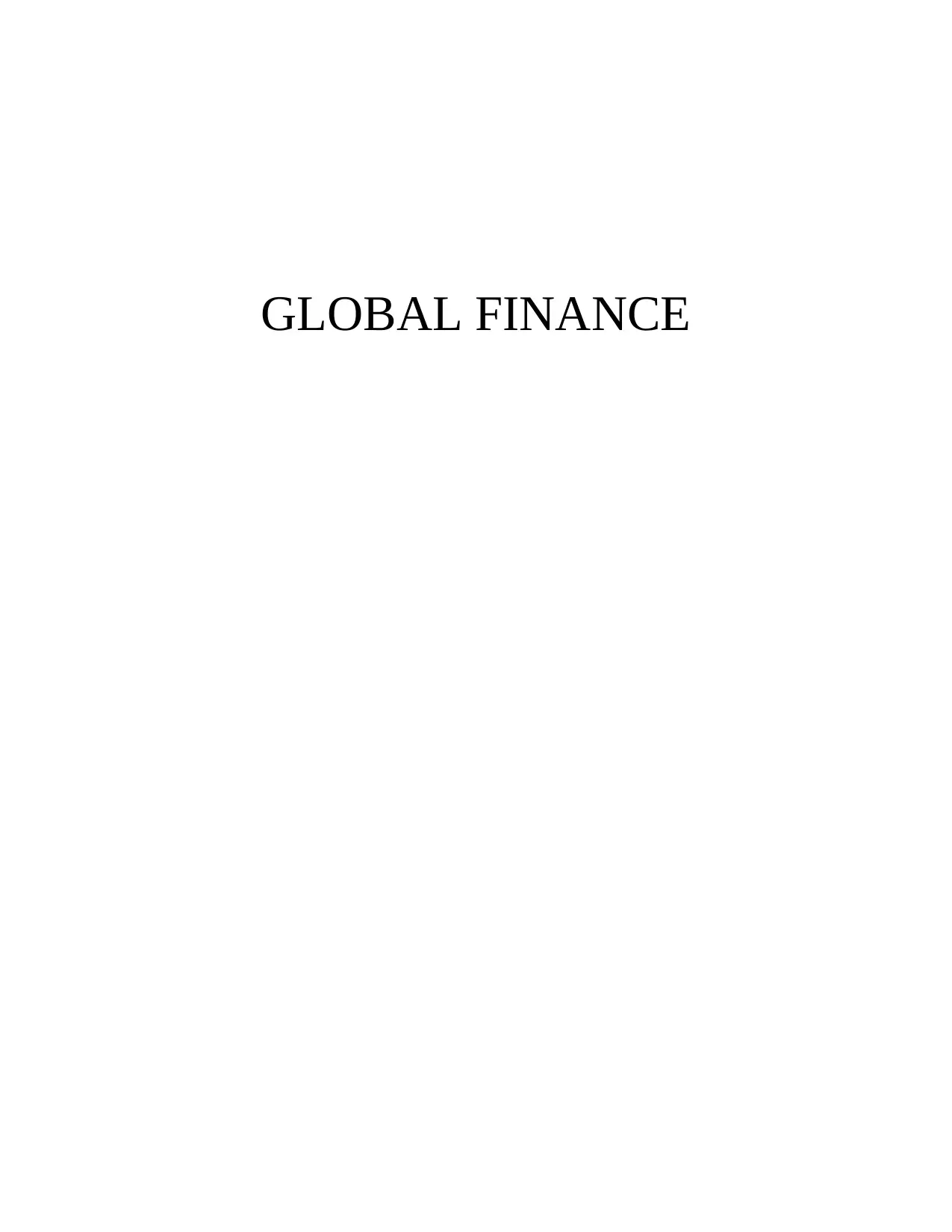
GLOBAL FINANCE
Secure Best Marks with AI Grader
Need help grading? Try our AI Grader for instant feedback on your assignments.
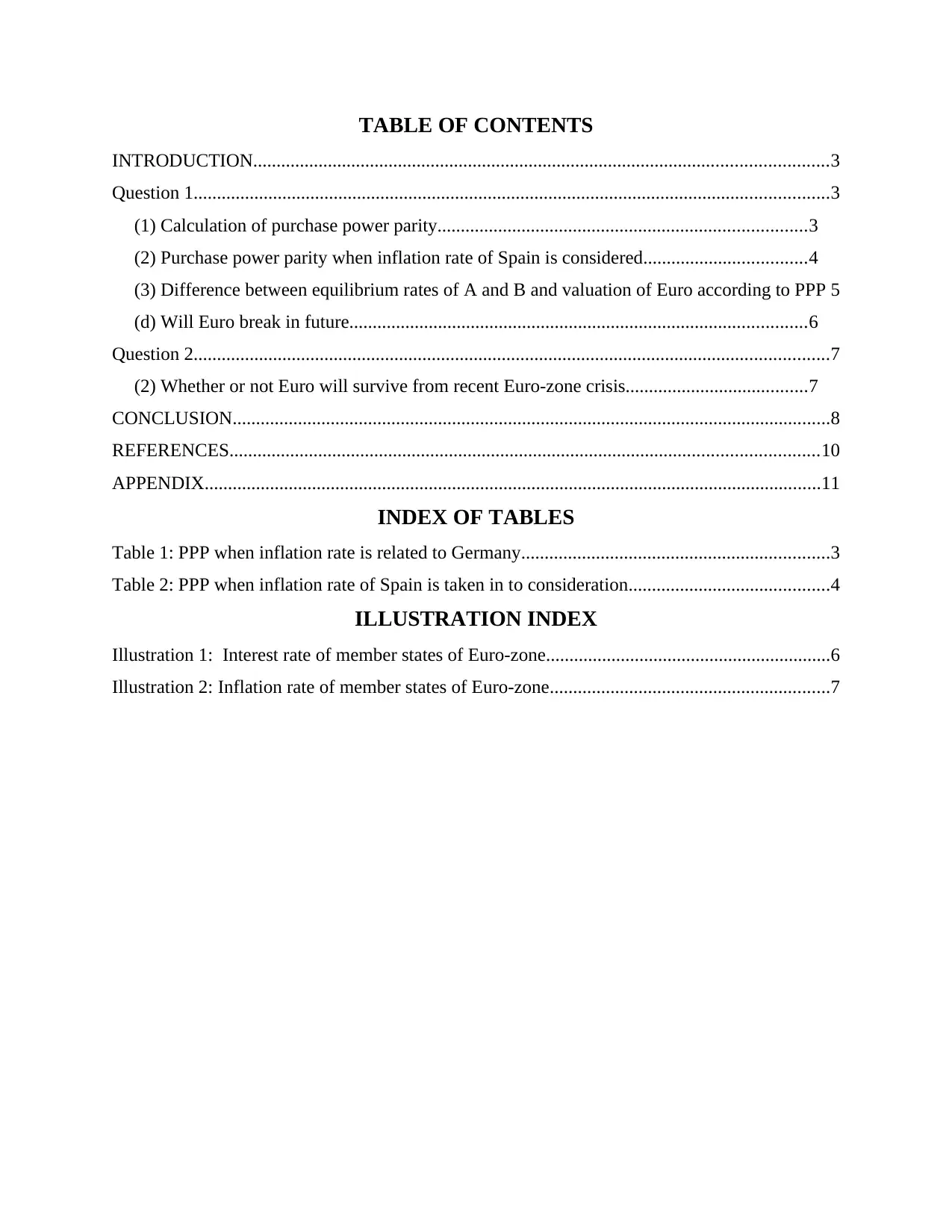
TABLE OF CONTENTS
INTRODUCTION...........................................................................................................................3
Question 1........................................................................................................................................3
(1) Calculation of purchase power parity...............................................................................3
(2) Purchase power parity when inflation rate of Spain is considered...................................4
(3) Difference between equilibrium rates of A and B and valuation of Euro according to PPP 5
(d) Will Euro break in future..................................................................................................6
Question 2........................................................................................................................................7
(2) Whether or not Euro will survive from recent Euro-zone crisis.......................................7
CONCLUSION................................................................................................................................8
REFERENCES..............................................................................................................................10
APPENDIX....................................................................................................................................11
INDEX OF TABLES
Table 1: PPP when inflation rate is related to Germany..................................................................3
Table 2: PPP when inflation rate of Spain is taken in to consideration...........................................4
ILLUSTRATION INDEX
Illustration 1: Interest rate of member states of Euro-zone.............................................................6
Illustration 2: Inflation rate of member states of Euro-zone............................................................7
INTRODUCTION...........................................................................................................................3
Question 1........................................................................................................................................3
(1) Calculation of purchase power parity...............................................................................3
(2) Purchase power parity when inflation rate of Spain is considered...................................4
(3) Difference between equilibrium rates of A and B and valuation of Euro according to PPP 5
(d) Will Euro break in future..................................................................................................6
Question 2........................................................................................................................................7
(2) Whether or not Euro will survive from recent Euro-zone crisis.......................................7
CONCLUSION................................................................................................................................8
REFERENCES..............................................................................................................................10
APPENDIX....................................................................................................................................11
INDEX OF TABLES
Table 1: PPP when inflation rate is related to Germany..................................................................3
Table 2: PPP when inflation rate of Spain is taken in to consideration...........................................4
ILLUSTRATION INDEX
Illustration 1: Interest rate of member states of Euro-zone.............................................................6
Illustration 2: Inflation rate of member states of Euro-zone............................................................7
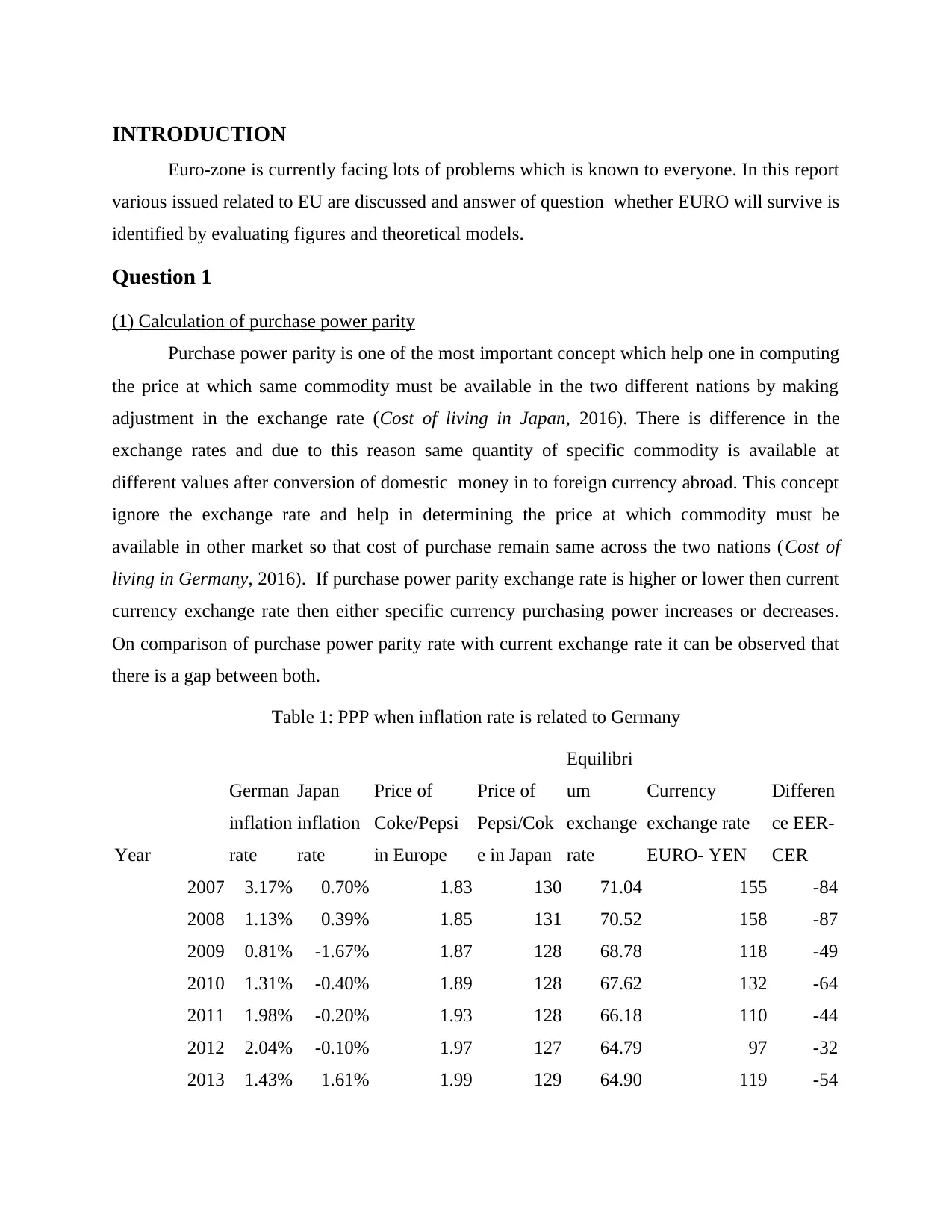
INTRODUCTION
Euro-zone is currently facing lots of problems which is known to everyone. In this report
various issued related to EU are discussed and answer of question whether EURO will survive is
identified by evaluating figures and theoretical models.
Question 1
(1) Calculation of purchase power parity
Purchase power parity is one of the most important concept which help one in computing
the price at which same commodity must be available in the two different nations by making
adjustment in the exchange rate (Cost of living in Japan, 2016). There is difference in the
exchange rates and due to this reason same quantity of specific commodity is available at
different values after conversion of domestic money in to foreign currency abroad. This concept
ignore the exchange rate and help in determining the price at which commodity must be
available in other market so that cost of purchase remain same across the two nations (Cost of
living in Germany, 2016). If purchase power parity exchange rate is higher or lower then current
currency exchange rate then either specific currency purchasing power increases or decreases.
On comparison of purchase power parity rate with current exchange rate it can be observed that
there is a gap between both.
Table 1: PPP when inflation rate is related to Germany
Year
German
inflation
rate
Japan
inflation
rate
Price of
Coke/Pepsi
in Europe
Price of
Pepsi/Cok
e in Japan
Equilibri
um
exchange
rate
Currency
exchange rate
EURO- YEN
Differen
ce EER-
CER
2007 3.17% 0.70% 1.83 130 71.04 155 -84
2008 1.13% 0.39% 1.85 131 70.52 158 -87
2009 0.81% -1.67% 1.87 128 68.78 118 -49
2010 1.31% -0.40% 1.89 128 67.62 132 -64
2011 1.98% -0.20% 1.93 128 66.18 110 -44
2012 2.04% -0.10% 1.97 127 64.79 97 -32
2013 1.43% 1.61% 1.99 129 64.90 119 -54
Euro-zone is currently facing lots of problems which is known to everyone. In this report
various issued related to EU are discussed and answer of question whether EURO will survive is
identified by evaluating figures and theoretical models.
Question 1
(1) Calculation of purchase power parity
Purchase power parity is one of the most important concept which help one in computing
the price at which same commodity must be available in the two different nations by making
adjustment in the exchange rate (Cost of living in Japan, 2016). There is difference in the
exchange rates and due to this reason same quantity of specific commodity is available at
different values after conversion of domestic money in to foreign currency abroad. This concept
ignore the exchange rate and help in determining the price at which commodity must be
available in other market so that cost of purchase remain same across the two nations (Cost of
living in Germany, 2016). If purchase power parity exchange rate is higher or lower then current
currency exchange rate then either specific currency purchasing power increases or decreases.
On comparison of purchase power parity rate with current exchange rate it can be observed that
there is a gap between both.
Table 1: PPP when inflation rate is related to Germany
Year
German
inflation
rate
Japan
inflation
rate
Price of
Coke/Pepsi
in Europe
Price of
Pepsi/Cok
e in Japan
Equilibri
um
exchange
rate
Currency
exchange rate
EURO- YEN
Differen
ce EER-
CER
2007 3.17% 0.70% 1.83 130 71.04 155 -84
2008 1.13% 0.39% 1.85 131 70.52 158 -87
2009 0.81% -1.67% 1.87 128 68.78 118 -49
2010 1.31% -0.40% 1.89 128 67.62 132 -64
2011 1.98% -0.20% 1.93 128 66.18 110 -44
2012 2.04% -0.10% 1.97 127 64.79 97 -32
2013 1.43% 1.61% 1.99 129 64.90 119 -54
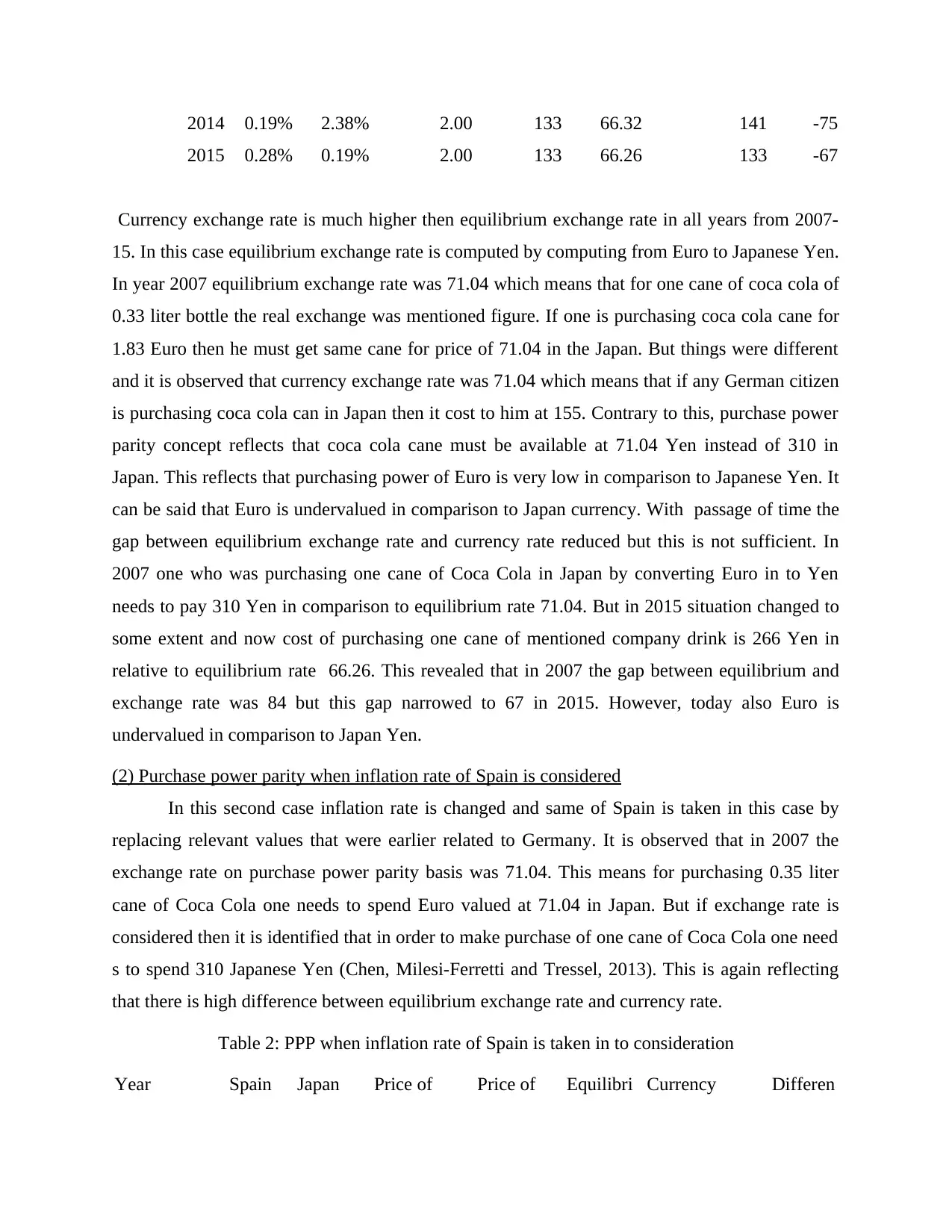
2014 0.19% 2.38% 2.00 133 66.32 141 -75
2015 0.28% 0.19% 2.00 133 66.26 133 -67
Currency exchange rate is much higher then equilibrium exchange rate in all years from 2007-
15. In this case equilibrium exchange rate is computed by computing from Euro to Japanese Yen.
In year 2007 equilibrium exchange rate was 71.04 which means that for one cane of coca cola of
0.33 liter bottle the real exchange was mentioned figure. If one is purchasing coca cola cane for
1.83 Euro then he must get same cane for price of 71.04 in the Japan. But things were different
and it is observed that currency exchange rate was 71.04 which means that if any German citizen
is purchasing coca cola can in Japan then it cost to him at 155. Contrary to this, purchase power
parity concept reflects that coca cola cane must be available at 71.04 Yen instead of 310 in
Japan. This reflects that purchasing power of Euro is very low in comparison to Japanese Yen. It
can be said that Euro is undervalued in comparison to Japan currency. With passage of time the
gap between equilibrium exchange rate and currency rate reduced but this is not sufficient. In
2007 one who was purchasing one cane of Coca Cola in Japan by converting Euro in to Yen
needs to pay 310 Yen in comparison to equilibrium rate 71.04. But in 2015 situation changed to
some extent and now cost of purchasing one cane of mentioned company drink is 266 Yen in
relative to equilibrium rate 66.26. This revealed that in 2007 the gap between equilibrium and
exchange rate was 84 but this gap narrowed to 67 in 2015. However, today also Euro is
undervalued in comparison to Japan Yen.
(2) Purchase power parity when inflation rate of Spain is considered
In this second case inflation rate is changed and same of Spain is taken in this case by
replacing relevant values that were earlier related to Germany. It is observed that in 2007 the
exchange rate on purchase power parity basis was 71.04. This means for purchasing 0.35 liter
cane of Coca Cola one needs to spend Euro valued at 71.04 in Japan. But if exchange rate is
considered then it is identified that in order to make purchase of one cane of Coca Cola one need
s to spend 310 Japanese Yen (Chen, Milesi-Ferretti and Tressel, 2013). This is again reflecting
that there is high difference between equilibrium exchange rate and currency rate.
Table 2: PPP when inflation rate of Spain is taken in to consideration
Year Spain Japan Price of Price of Equilibri Currency Differen
2015 0.28% 0.19% 2.00 133 66.26 133 -67
Currency exchange rate is much higher then equilibrium exchange rate in all years from 2007-
15. In this case equilibrium exchange rate is computed by computing from Euro to Japanese Yen.
In year 2007 equilibrium exchange rate was 71.04 which means that for one cane of coca cola of
0.33 liter bottle the real exchange was mentioned figure. If one is purchasing coca cola cane for
1.83 Euro then he must get same cane for price of 71.04 in the Japan. But things were different
and it is observed that currency exchange rate was 71.04 which means that if any German citizen
is purchasing coca cola can in Japan then it cost to him at 155. Contrary to this, purchase power
parity concept reflects that coca cola cane must be available at 71.04 Yen instead of 310 in
Japan. This reflects that purchasing power of Euro is very low in comparison to Japanese Yen. It
can be said that Euro is undervalued in comparison to Japan currency. With passage of time the
gap between equilibrium exchange rate and currency rate reduced but this is not sufficient. In
2007 one who was purchasing one cane of Coca Cola in Japan by converting Euro in to Yen
needs to pay 310 Yen in comparison to equilibrium rate 71.04. But in 2015 situation changed to
some extent and now cost of purchasing one cane of mentioned company drink is 266 Yen in
relative to equilibrium rate 66.26. This revealed that in 2007 the gap between equilibrium and
exchange rate was 84 but this gap narrowed to 67 in 2015. However, today also Euro is
undervalued in comparison to Japan Yen.
(2) Purchase power parity when inflation rate of Spain is considered
In this second case inflation rate is changed and same of Spain is taken in this case by
replacing relevant values that were earlier related to Germany. It is observed that in 2007 the
exchange rate on purchase power parity basis was 71.04. This means for purchasing 0.35 liter
cane of Coca Cola one needs to spend Euro valued at 71.04 in Japan. But if exchange rate is
considered then it is identified that in order to make purchase of one cane of Coca Cola one need
s to spend 310 Japanese Yen (Chen, Milesi-Ferretti and Tressel, 2013). This is again reflecting
that there is high difference between equilibrium exchange rate and currency rate.
Table 2: PPP when inflation rate of Spain is taken in to consideration
Year Spain Japan Price of Price of Equilibri Currency Differen
Secure Best Marks with AI Grader
Need help grading? Try our AI Grader for instant feedback on your assignments.
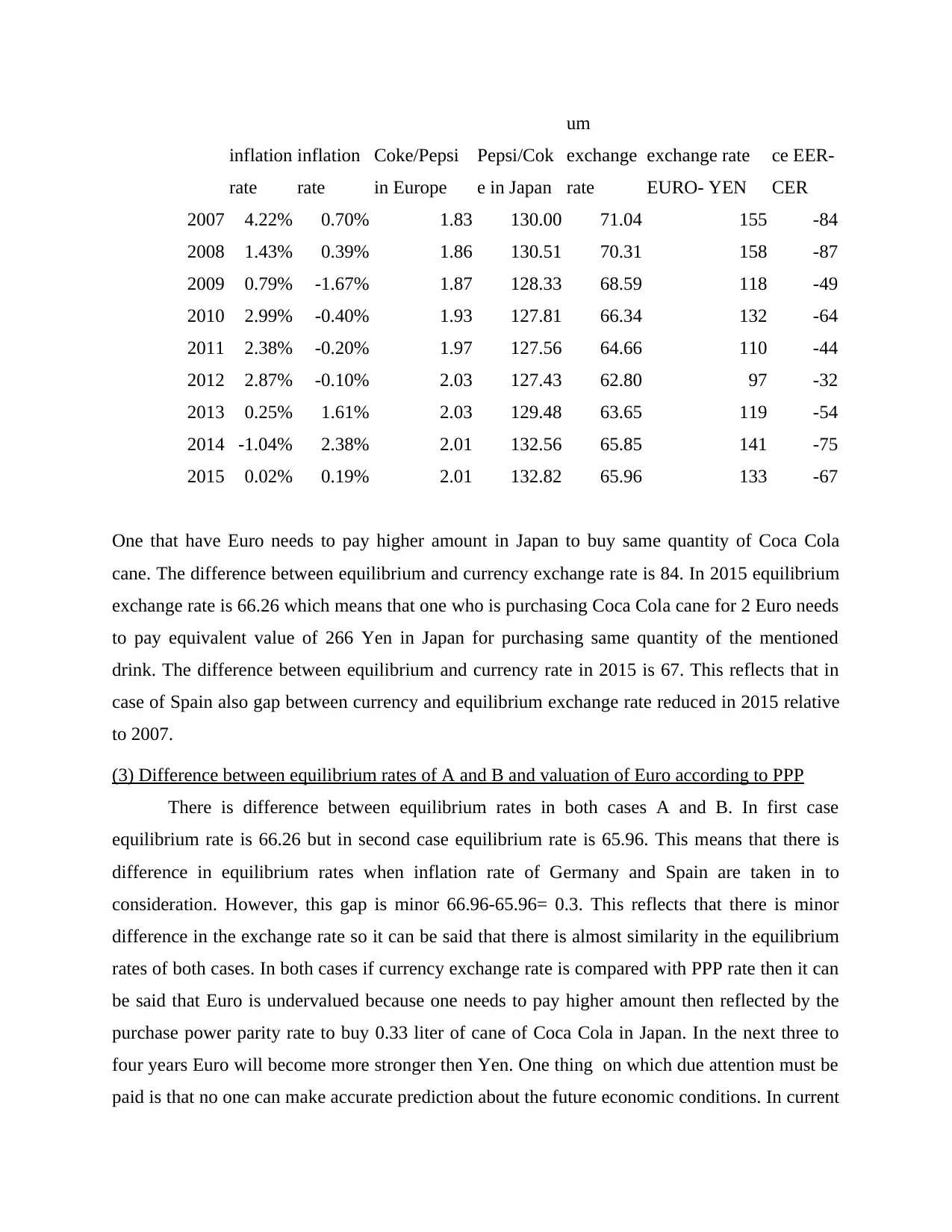
inflation
rate
inflation
rate
Coke/Pepsi
in Europe
Pepsi/Cok
e in Japan
um
exchange
rate
exchange rate
EURO- YEN
ce EER-
CER
2007 4.22% 0.70% 1.83 130.00 71.04 155 -84
2008 1.43% 0.39% 1.86 130.51 70.31 158 -87
2009 0.79% -1.67% 1.87 128.33 68.59 118 -49
2010 2.99% -0.40% 1.93 127.81 66.34 132 -64
2011 2.38% -0.20% 1.97 127.56 64.66 110 -44
2012 2.87% -0.10% 2.03 127.43 62.80 97 -32
2013 0.25% 1.61% 2.03 129.48 63.65 119 -54
2014 -1.04% 2.38% 2.01 132.56 65.85 141 -75
2015 0.02% 0.19% 2.01 132.82 65.96 133 -67
One that have Euro needs to pay higher amount in Japan to buy same quantity of Coca Cola
cane. The difference between equilibrium and currency exchange rate is 84. In 2015 equilibrium
exchange rate is 66.26 which means that one who is purchasing Coca Cola cane for 2 Euro needs
to pay equivalent value of 266 Yen in Japan for purchasing same quantity of the mentioned
drink. The difference between equilibrium and currency rate in 2015 is 67. This reflects that in
case of Spain also gap between currency and equilibrium exchange rate reduced in 2015 relative
to 2007.
(3) Difference between equilibrium rates of A and B and valuation of Euro according to PPP
There is difference between equilibrium rates in both cases A and B. In first case
equilibrium rate is 66.26 but in second case equilibrium rate is 65.96. This means that there is
difference in equilibrium rates when inflation rate of Germany and Spain are taken in to
consideration. However, this gap is minor 66.96-65.96= 0.3. This reflects that there is minor
difference in the exchange rate so it can be said that there is almost similarity in the equilibrium
rates of both cases. In both cases if currency exchange rate is compared with PPP rate then it can
be said that Euro is undervalued because one needs to pay higher amount then reflected by the
purchase power parity rate to buy 0.33 liter of cane of Coca Cola in Japan. In the next three to
four years Euro will become more stronger then Yen. One thing on which due attention must be
paid is that no one can make accurate prediction about the future economic conditions. In current
rate
inflation
rate
Coke/Pepsi
in Europe
Pepsi/Cok
e in Japan
um
exchange
rate
exchange rate
EURO- YEN
ce EER-
CER
2007 4.22% 0.70% 1.83 130.00 71.04 155 -84
2008 1.43% 0.39% 1.86 130.51 70.31 158 -87
2009 0.79% -1.67% 1.87 128.33 68.59 118 -49
2010 2.99% -0.40% 1.93 127.81 66.34 132 -64
2011 2.38% -0.20% 1.97 127.56 64.66 110 -44
2012 2.87% -0.10% 2.03 127.43 62.80 97 -32
2013 0.25% 1.61% 2.03 129.48 63.65 119 -54
2014 -1.04% 2.38% 2.01 132.56 65.85 141 -75
2015 0.02% 0.19% 2.01 132.82 65.96 133 -67
One that have Euro needs to pay higher amount in Japan to buy same quantity of Coca Cola
cane. The difference between equilibrium and currency exchange rate is 84. In 2015 equilibrium
exchange rate is 66.26 which means that one who is purchasing Coca Cola cane for 2 Euro needs
to pay equivalent value of 266 Yen in Japan for purchasing same quantity of the mentioned
drink. The difference between equilibrium and currency rate in 2015 is 67. This reflects that in
case of Spain also gap between currency and equilibrium exchange rate reduced in 2015 relative
to 2007.
(3) Difference between equilibrium rates of A and B and valuation of Euro according to PPP
There is difference between equilibrium rates in both cases A and B. In first case
equilibrium rate is 66.26 but in second case equilibrium rate is 65.96. This means that there is
difference in equilibrium rates when inflation rate of Germany and Spain are taken in to
consideration. However, this gap is minor 66.96-65.96= 0.3. This reflects that there is minor
difference in the exchange rate so it can be said that there is almost similarity in the equilibrium
rates of both cases. In both cases if currency exchange rate is compared with PPP rate then it can
be said that Euro is undervalued because one needs to pay higher amount then reflected by the
purchase power parity rate to buy 0.33 liter of cane of Coca Cola in Japan. In the next three to
four years Euro will become more stronger then Yen. One thing on which due attention must be
paid is that no one can make accurate prediction about the future economic conditions. In current
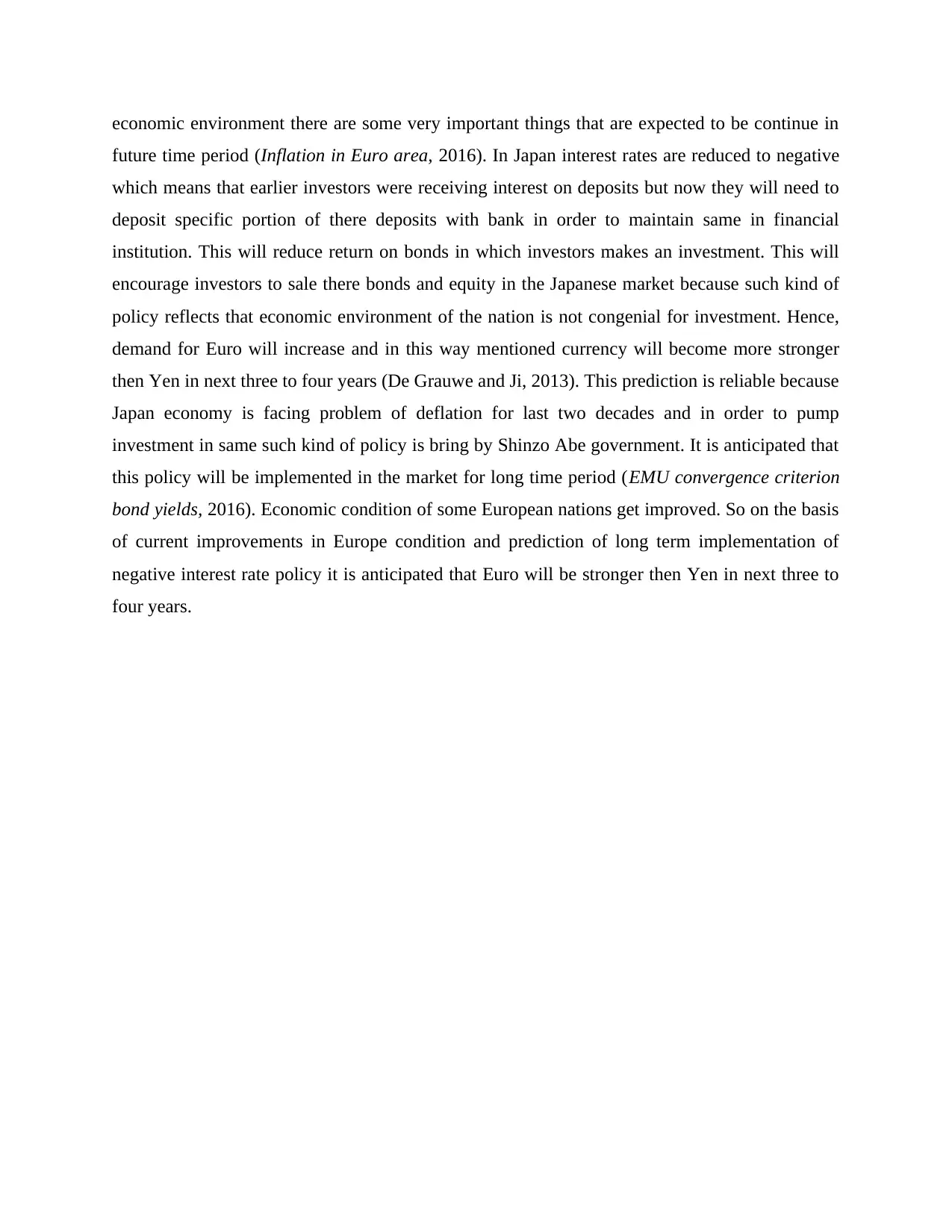
economic environment there are some very important things that are expected to be continue in
future time period (Inflation in Euro area, 2016). In Japan interest rates are reduced to negative
which means that earlier investors were receiving interest on deposits but now they will need to
deposit specific portion of there deposits with bank in order to maintain same in financial
institution. This will reduce return on bonds in which investors makes an investment. This will
encourage investors to sale there bonds and equity in the Japanese market because such kind of
policy reflects that economic environment of the nation is not congenial for investment. Hence,
demand for Euro will increase and in this way mentioned currency will become more stronger
then Yen in next three to four years (De Grauwe and Ji, 2013). This prediction is reliable because
Japan economy is facing problem of deflation for last two decades and in order to pump
investment in same such kind of policy is bring by Shinzo Abe government. It is anticipated that
this policy will be implemented in the market for long time period (EMU convergence criterion
bond yields, 2016). Economic condition of some European nations get improved. So on the basis
of current improvements in Europe condition and prediction of long term implementation of
negative interest rate policy it is anticipated that Euro will be stronger then Yen in next three to
four years.
future time period (Inflation in Euro area, 2016). In Japan interest rates are reduced to negative
which means that earlier investors were receiving interest on deposits but now they will need to
deposit specific portion of there deposits with bank in order to maintain same in financial
institution. This will reduce return on bonds in which investors makes an investment. This will
encourage investors to sale there bonds and equity in the Japanese market because such kind of
policy reflects that economic environment of the nation is not congenial for investment. Hence,
demand for Euro will increase and in this way mentioned currency will become more stronger
then Yen in next three to four years (De Grauwe and Ji, 2013). This prediction is reliable because
Japan economy is facing problem of deflation for last two decades and in order to pump
investment in same such kind of policy is bring by Shinzo Abe government. It is anticipated that
this policy will be implemented in the market for long time period (EMU convergence criterion
bond yields, 2016). Economic condition of some European nations get improved. So on the basis
of current improvements in Europe condition and prediction of long term implementation of
negative interest rate policy it is anticipated that Euro will be stronger then Yen in next three to
four years.
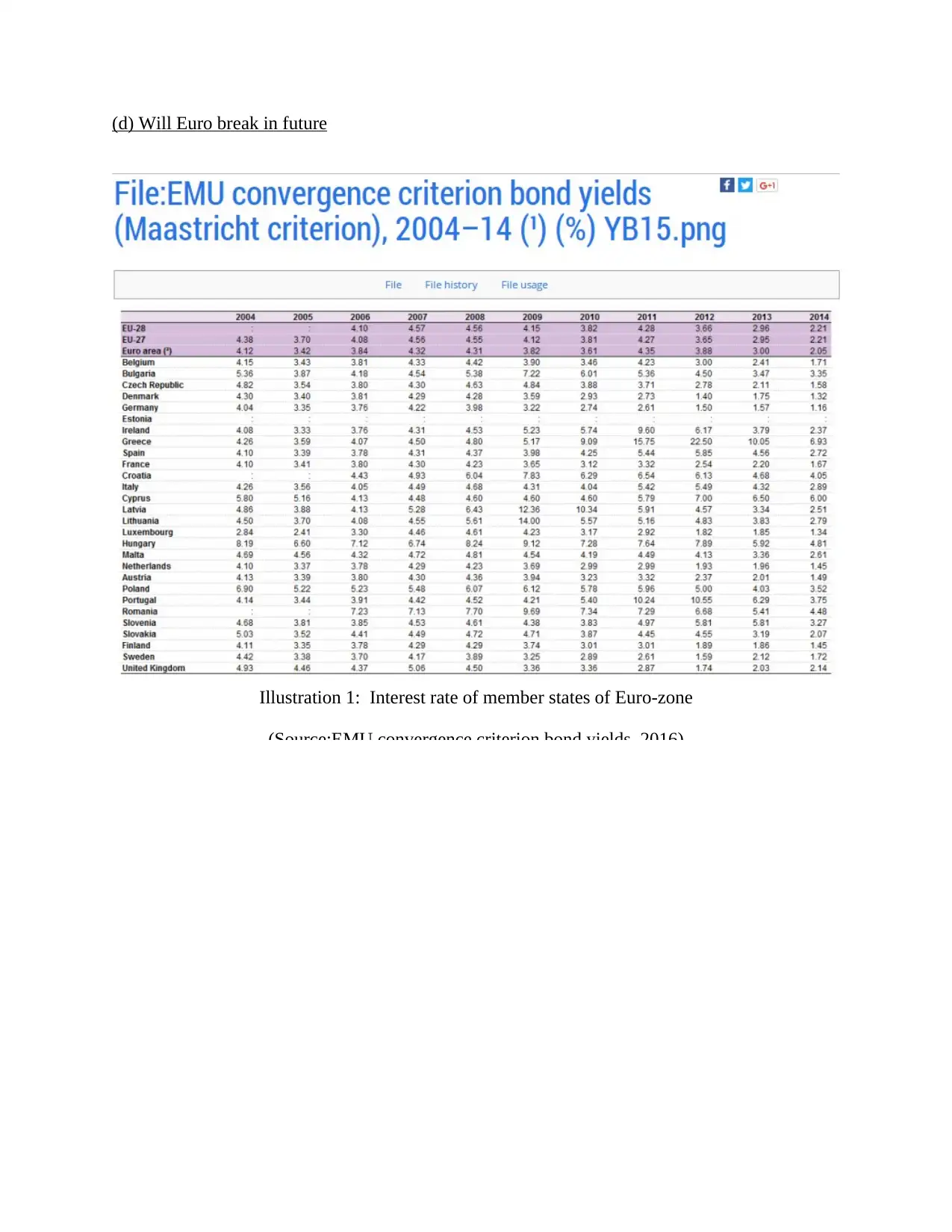
(d) Will Euro break in future
Illustration 1: Interest rate of member states of Euro-zone
(Source:EMU convergence criterion bond yields, 2016)
Illustration 1: Interest rate of member states of Euro-zone
(Source:EMU convergence criterion bond yields, 2016)
Paraphrase This Document
Need a fresh take? Get an instant paraphrase of this document with our AI Paraphraser
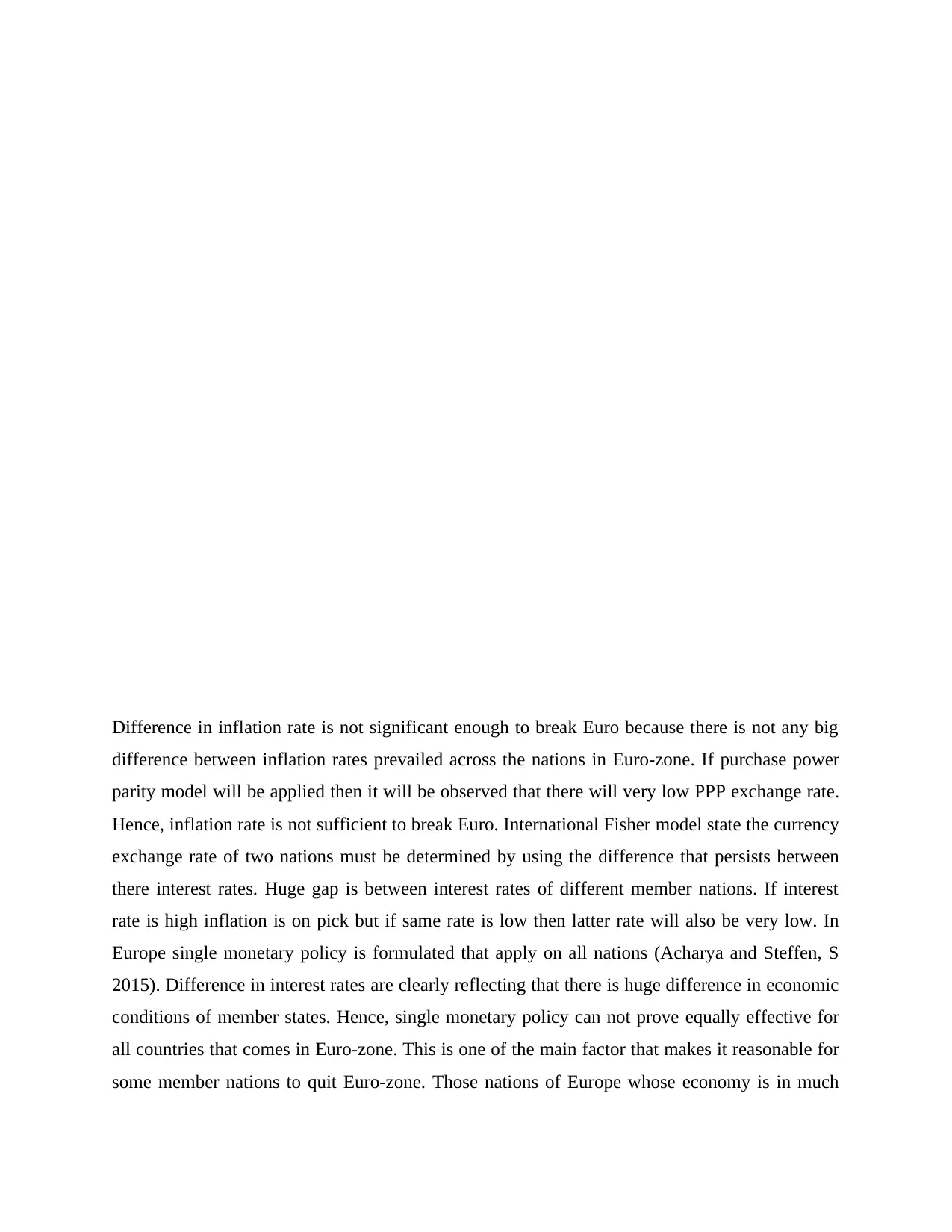
Difference in inflation rate is not significant enough to break Euro because there is not any big
difference between inflation rates prevailed across the nations in Euro-zone. If purchase power
parity model will be applied then it will be observed that there will very low PPP exchange rate.
Hence, inflation rate is not sufficient to break Euro. International Fisher model state the currency
exchange rate of two nations must be determined by using the difference that persists between
there interest rates. Huge gap is between interest rates of different member nations. If interest
rate is high inflation is on pick but if same rate is low then latter rate will also be very low. In
Europe single monetary policy is formulated that apply on all nations (Acharya and Steffen, S
2015). Difference in interest rates are clearly reflecting that there is huge difference in economic
conditions of member states. Hence, single monetary policy can not prove equally effective for
all countries that comes in Euro-zone. This is one of the main factor that makes it reasonable for
some member nations to quit Euro-zone. Those nations of Europe whose economy is in much
difference between inflation rates prevailed across the nations in Euro-zone. If purchase power
parity model will be applied then it will be observed that there will very low PPP exchange rate.
Hence, inflation rate is not sufficient to break Euro. International Fisher model state the currency
exchange rate of two nations must be determined by using the difference that persists between
there interest rates. Huge gap is between interest rates of different member nations. If interest
rate is high inflation is on pick but if same rate is low then latter rate will also be very low. In
Europe single monetary policy is formulated that apply on all nations (Acharya and Steffen, S
2015). Difference in interest rates are clearly reflecting that there is huge difference in economic
conditions of member states. Hence, single monetary policy can not prove equally effective for
all countries that comes in Euro-zone. This is one of the main factor that makes it reasonable for
some member nations to quit Euro-zone. Those nations of Europe whose economy is in much
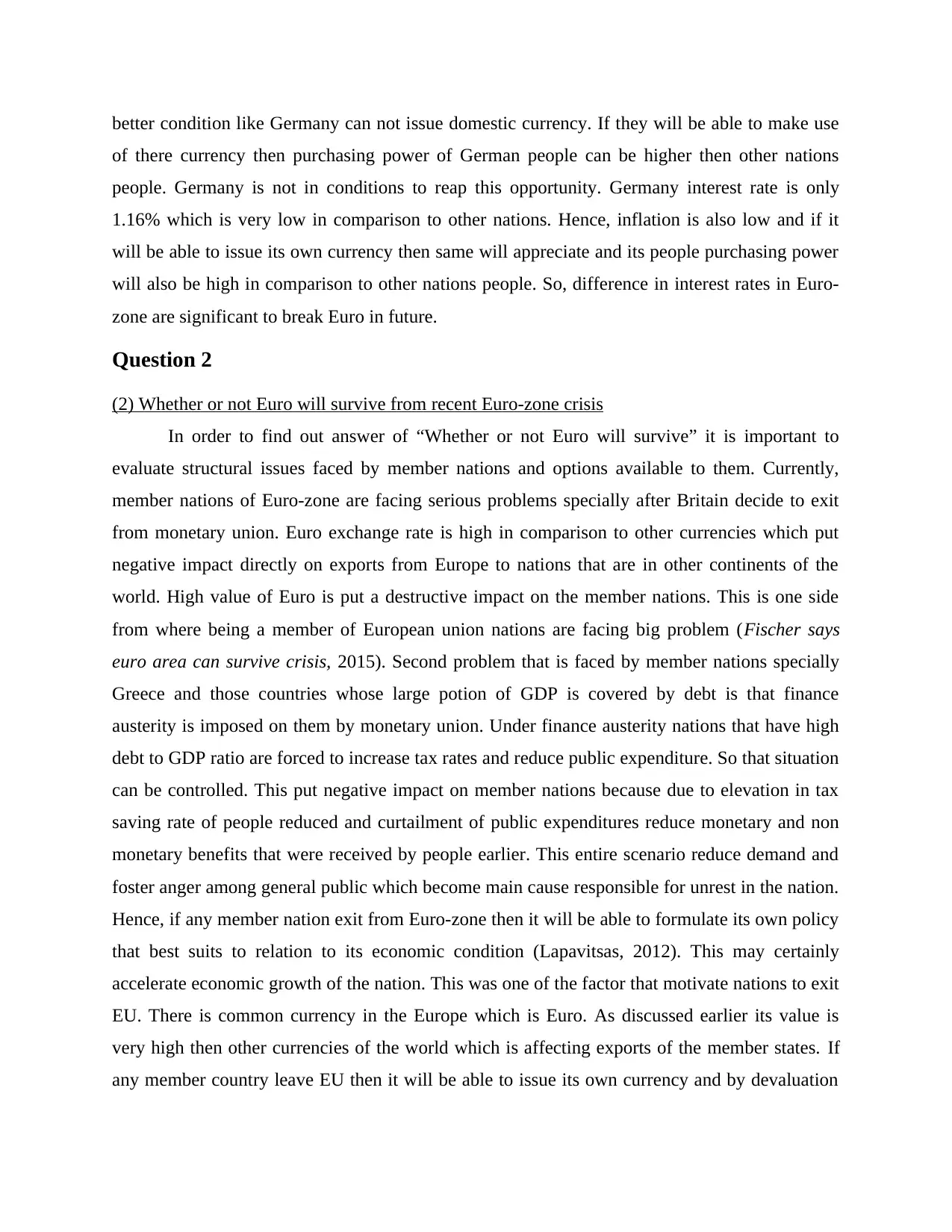
better condition like Germany can not issue domestic currency. If they will be able to make use
of there currency then purchasing power of German people can be higher then other nations
people. Germany is not in conditions to reap this opportunity. Germany interest rate is only
1.16% which is very low in comparison to other nations. Hence, inflation is also low and if it
will be able to issue its own currency then same will appreciate and its people purchasing power
will also be high in comparison to other nations people. So, difference in interest rates in Euro-
zone are significant to break Euro in future.
Question 2
(2) Whether or not Euro will survive from recent Euro-zone crisis
In order to find out answer of “Whether or not Euro will survive” it is important to
evaluate structural issues faced by member nations and options available to them. Currently,
member nations of Euro-zone are facing serious problems specially after Britain decide to exit
from monetary union. Euro exchange rate is high in comparison to other currencies which put
negative impact directly on exports from Europe to nations that are in other continents of the
world. High value of Euro is put a destructive impact on the member nations. This is one side
from where being a member of European union nations are facing big problem (Fischer says
euro area can survive crisis, 2015). Second problem that is faced by member nations specially
Greece and those countries whose large potion of GDP is covered by debt is that finance
austerity is imposed on them by monetary union. Under finance austerity nations that have high
debt to GDP ratio are forced to increase tax rates and reduce public expenditure. So that situation
can be controlled. This put negative impact on member nations because due to elevation in tax
saving rate of people reduced and curtailment of public expenditures reduce monetary and non
monetary benefits that were received by people earlier. This entire scenario reduce demand and
foster anger among general public which become main cause responsible for unrest in the nation.
Hence, if any member nation exit from Euro-zone then it will be able to formulate its own policy
that best suits to relation to its economic condition (Lapavitsas, 2012). This may certainly
accelerate economic growth of the nation. This was one of the factor that motivate nations to exit
EU. There is common currency in the Europe which is Euro. As discussed earlier its value is
very high then other currencies of the world which is affecting exports of the member states. If
any member country leave EU then it will be able to issue its own currency and by devaluation
of there currency then purchasing power of German people can be higher then other nations
people. Germany is not in conditions to reap this opportunity. Germany interest rate is only
1.16% which is very low in comparison to other nations. Hence, inflation is also low and if it
will be able to issue its own currency then same will appreciate and its people purchasing power
will also be high in comparison to other nations people. So, difference in interest rates in Euro-
zone are significant to break Euro in future.
Question 2
(2) Whether or not Euro will survive from recent Euro-zone crisis
In order to find out answer of “Whether or not Euro will survive” it is important to
evaluate structural issues faced by member nations and options available to them. Currently,
member nations of Euro-zone are facing serious problems specially after Britain decide to exit
from monetary union. Euro exchange rate is high in comparison to other currencies which put
negative impact directly on exports from Europe to nations that are in other continents of the
world. High value of Euro is put a destructive impact on the member nations. This is one side
from where being a member of European union nations are facing big problem (Fischer says
euro area can survive crisis, 2015). Second problem that is faced by member nations specially
Greece and those countries whose large potion of GDP is covered by debt is that finance
austerity is imposed on them by monetary union. Under finance austerity nations that have high
debt to GDP ratio are forced to increase tax rates and reduce public expenditure. So that situation
can be controlled. This put negative impact on member nations because due to elevation in tax
saving rate of people reduced and curtailment of public expenditures reduce monetary and non
monetary benefits that were received by people earlier. This entire scenario reduce demand and
foster anger among general public which become main cause responsible for unrest in the nation.
Hence, if any member nation exit from Euro-zone then it will be able to formulate its own policy
that best suits to relation to its economic condition (Lapavitsas, 2012). This may certainly
accelerate economic growth of the nation. This was one of the factor that motivate nations to exit
EU. There is common currency in the Europe which is Euro. As discussed earlier its value is
very high then other currencies of the world which is affecting exports of the member states. If
any member country leave EU then it will be able to issue its own currency and by devaluation
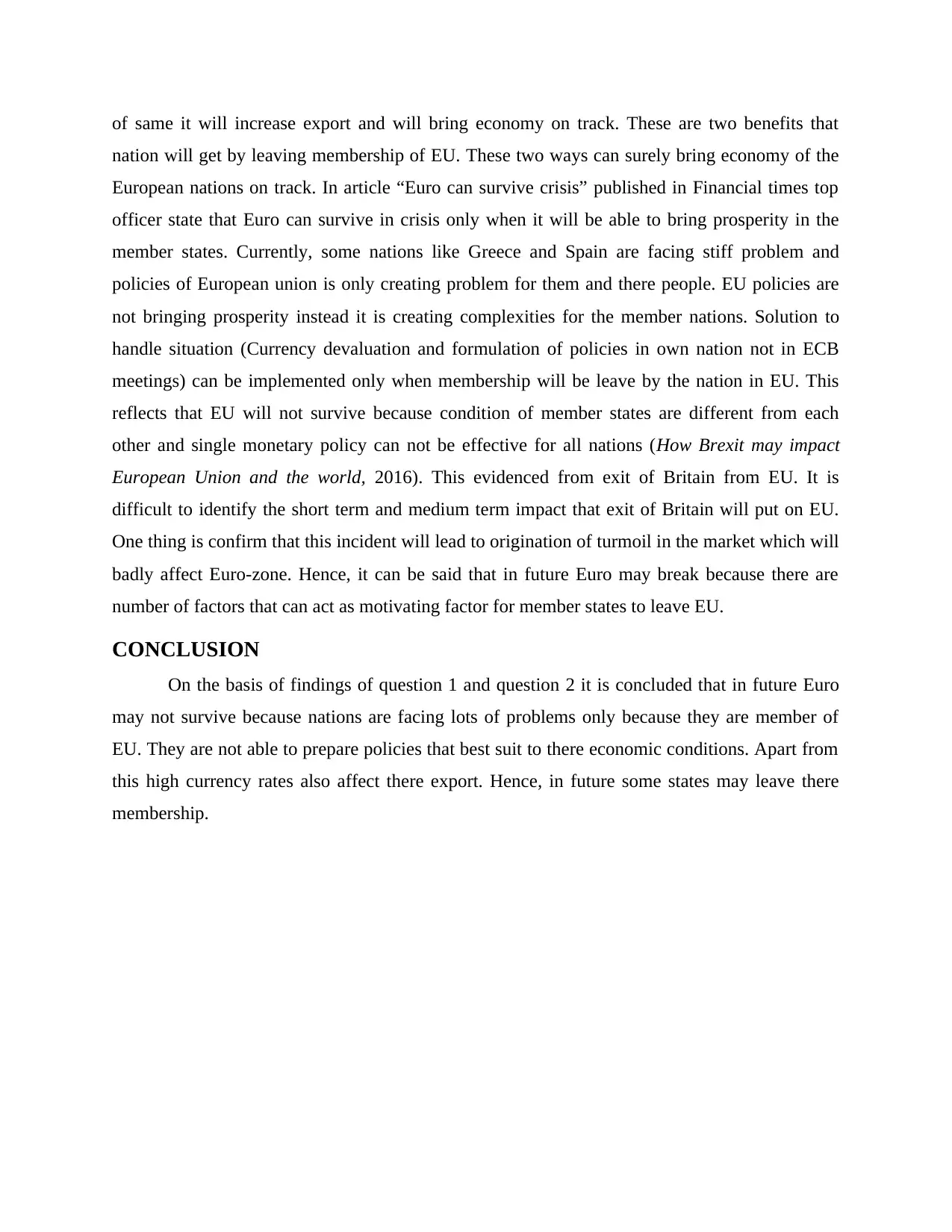
of same it will increase export and will bring economy on track. These are two benefits that
nation will get by leaving membership of EU. These two ways can surely bring economy of the
European nations on track. In article “Euro can survive crisis” published in Financial times top
officer state that Euro can survive in crisis only when it will be able to bring prosperity in the
member states. Currently, some nations like Greece and Spain are facing stiff problem and
policies of European union is only creating problem for them and there people. EU policies are
not bringing prosperity instead it is creating complexities for the member nations. Solution to
handle situation (Currency devaluation and formulation of policies in own nation not in ECB
meetings) can be implemented only when membership will be leave by the nation in EU. This
reflects that EU will not survive because condition of member states are different from each
other and single monetary policy can not be effective for all nations (How Brexit may impact
European Union and the world, 2016). This evidenced from exit of Britain from EU. It is
difficult to identify the short term and medium term impact that exit of Britain will put on EU.
One thing is confirm that this incident will lead to origination of turmoil in the market which will
badly affect Euro-zone. Hence, it can be said that in future Euro may break because there are
number of factors that can act as motivating factor for member states to leave EU.
CONCLUSION
On the basis of findings of question 1 and question 2 it is concluded that in future Euro
may not survive because nations are facing lots of problems only because they are member of
EU. They are not able to prepare policies that best suit to there economic conditions. Apart from
this high currency rates also affect there export. Hence, in future some states may leave there
membership.
nation will get by leaving membership of EU. These two ways can surely bring economy of the
European nations on track. In article “Euro can survive crisis” published in Financial times top
officer state that Euro can survive in crisis only when it will be able to bring prosperity in the
member states. Currently, some nations like Greece and Spain are facing stiff problem and
policies of European union is only creating problem for them and there people. EU policies are
not bringing prosperity instead it is creating complexities for the member nations. Solution to
handle situation (Currency devaluation and formulation of policies in own nation not in ECB
meetings) can be implemented only when membership will be leave by the nation in EU. This
reflects that EU will not survive because condition of member states are different from each
other and single monetary policy can not be effective for all nations (How Brexit may impact
European Union and the world, 2016). This evidenced from exit of Britain from EU. It is
difficult to identify the short term and medium term impact that exit of Britain will put on EU.
One thing is confirm that this incident will lead to origination of turmoil in the market which will
badly affect Euro-zone. Hence, it can be said that in future Euro may break because there are
number of factors that can act as motivating factor for member states to leave EU.
CONCLUSION
On the basis of findings of question 1 and question 2 it is concluded that in future Euro
may not survive because nations are facing lots of problems only because they are member of
EU. They are not able to prepare policies that best suit to there economic conditions. Apart from
this high currency rates also affect there export. Hence, in future some states may leave there
membership.
Secure Best Marks with AI Grader
Need help grading? Try our AI Grader for instant feedback on your assignments.
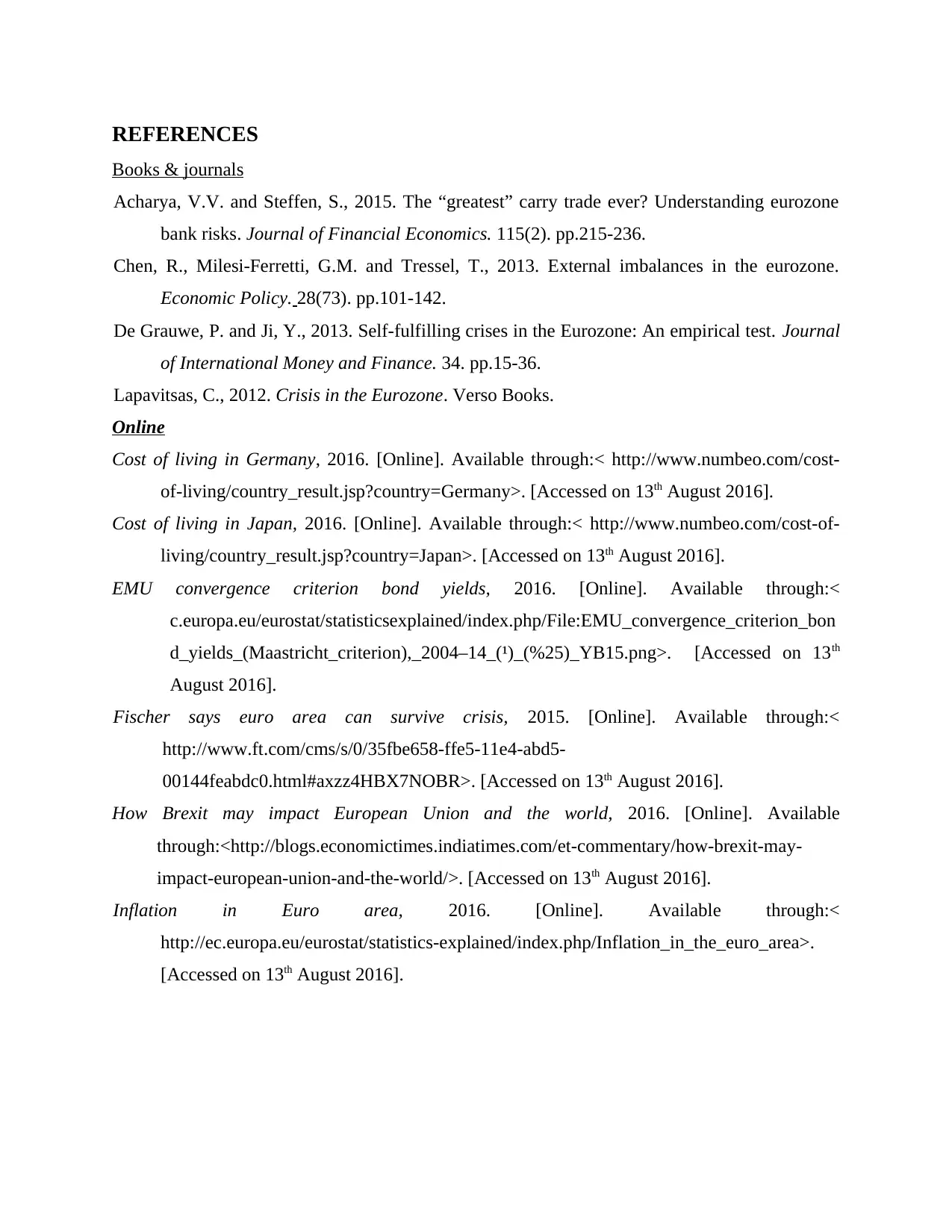
REFERENCES
Books & journals
Acharya, V.V. and Steffen, S., 2015. The “greatest” carry trade ever? Understanding eurozone
bank risks. Journal of Financial Economics. 115(2). pp.215-236.
Chen, R., Milesi-Ferretti, G.M. and Tressel, T., 2013. External imbalances in the eurozone.
Economic Policy. 28(73). pp.101-142.
De Grauwe, P. and Ji, Y., 2013. Self-fulfilling crises in the Eurozone: An empirical test. Journal
of International Money and Finance. 34. pp.15-36.
Lapavitsas, C., 2012. Crisis in the Eurozone. Verso Books.
Online
Cost of living in Germany, 2016. [Online]. Available through:< http://www.numbeo.com/cost-
of-living/country_result.jsp?country=Germany>. [Accessed on 13th August 2016].
Cost of living in Japan, 2016. [Online]. Available through:< http://www.numbeo.com/cost-of-
living/country_result.jsp?country=Japan>. [Accessed on 13th August 2016].
EMU convergence criterion bond yields, 2016. [Online]. Available through:<
c.europa.eu/eurostat/statisticsexplained/index.php/File:EMU_convergence_criterion_bon
d_yields_(Maastricht_criterion),_2004–14_(¹)_(%25)_YB15.png>. [Accessed on 13th
August 2016].
Fischer says euro area can survive crisis, 2015. [Online]. Available through:<
http://www.ft.com/cms/s/0/35fbe658-ffe5-11e4-abd5-
00144feabdc0.html#axzz4HBX7NOBR>. [Accessed on 13th August 2016].
How Brexit may impact European Union and the world, 2016. [Online]. Available
through:<http://blogs.economictimes.indiatimes.com/et-commentary/how-brexit-may-
impact-european-union-and-the-world/>. [Accessed on 13th August 2016].
Inflation in Euro area, 2016. [Online]. Available through:<
http://ec.europa.eu/eurostat/statistics-explained/index.php/Inflation_in_the_euro_area>.
[Accessed on 13th August 2016].
Books & journals
Acharya, V.V. and Steffen, S., 2015. The “greatest” carry trade ever? Understanding eurozone
bank risks. Journal of Financial Economics. 115(2). pp.215-236.
Chen, R., Milesi-Ferretti, G.M. and Tressel, T., 2013. External imbalances in the eurozone.
Economic Policy. 28(73). pp.101-142.
De Grauwe, P. and Ji, Y., 2013. Self-fulfilling crises in the Eurozone: An empirical test. Journal
of International Money and Finance. 34. pp.15-36.
Lapavitsas, C., 2012. Crisis in the Eurozone. Verso Books.
Online
Cost of living in Germany, 2016. [Online]. Available through:< http://www.numbeo.com/cost-
of-living/country_result.jsp?country=Germany>. [Accessed on 13th August 2016].
Cost of living in Japan, 2016. [Online]. Available through:< http://www.numbeo.com/cost-of-
living/country_result.jsp?country=Japan>. [Accessed on 13th August 2016].
EMU convergence criterion bond yields, 2016. [Online]. Available through:<
c.europa.eu/eurostat/statisticsexplained/index.php/File:EMU_convergence_criterion_bon
d_yields_(Maastricht_criterion),_2004–14_(¹)_(%25)_YB15.png>. [Accessed on 13th
August 2016].
Fischer says euro area can survive crisis, 2015. [Online]. Available through:<
http://www.ft.com/cms/s/0/35fbe658-ffe5-11e4-abd5-
00144feabdc0.html#axzz4HBX7NOBR>. [Accessed on 13th August 2016].
How Brexit may impact European Union and the world, 2016. [Online]. Available
through:<http://blogs.economictimes.indiatimes.com/et-commentary/how-brexit-may-
impact-european-union-and-the-world/>. [Accessed on 13th August 2016].
Inflation in Euro area, 2016. [Online]. Available through:<
http://ec.europa.eu/eurostat/statistics-explained/index.php/Inflation_in_the_euro_area>.
[Accessed on 13th August 2016].
1 out of 11
Your All-in-One AI-Powered Toolkit for Academic Success.
+13062052269
info@desklib.com
Available 24*7 on WhatsApp / Email
![[object Object]](/_next/static/media/star-bottom.7253800d.svg)
Unlock your academic potential
© 2024 | Zucol Services PVT LTD | All rights reserved.

